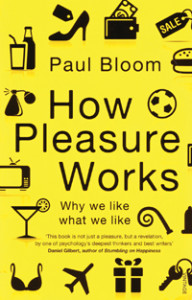How Pleasure Works
Why we like what we like
by Paul Bloom. Published by Vintage Books www.vintage-books.co.uk
The first thing you want to do with a book like this is turn to the chapter on sex (it’s OK, you can admit it, we’re all friends here). Unfortunately, with “How Pleasure Works” you are going to be disappointed as there isn’t one. Despite the slightly suggestive title and cover, the book is mostly devoid of the more salacious aspects of pleasure. Mostly – a brief interview with a masochist in the dungeon of an… inventive… dominatrix being the only real exception. No, the simple pleasures of sex, food and sleep are not the subject of Mr Bloom’s book. Rather, he asks why we get more pleasure from a vintage than a table wine, why a genuine Vermeer is priceless while an identical copy is worthless and why anyone would pay forty thousand dollars for John F. Kennedy’s tape measure.
There are the obvious pleasures of course – we like what we learn to like. If we first taste ice cream during a wonderful summer holiday then forever after ice cream doesn’t just taste of ice cream, it tastes of summer.
There’s fiction too. At a basic level our brains can’t tell imagination from real life. Your TV friends provide you with the same emotional benefits as flesh and blood plus are better looking and funnier – life with the dull bits left out. We can also enjoy fiction as ‘reality-lite’ where the real thing is too dangerous or expensive (Bond is bullet-proof, you aren’t) or to let our imagination ‘scout ahead’. You learn about death from Dumbledore and CPR from ER.
Bloom explores a variety of pleasure theories, but his main argument is the enjoyment of the imperceptible, for, to Bloom, we are all “Essentialists’.
Élan, chi, mana – the essential, invisible essence that makes things and people what they are is a constant in every culture. From the forest spirits of Amazon tribes to the footballer’s lucky shirt, Essentialism is built into the human psyche. Rarely explicitly acknowledged in modern society, we still all want more of it. A primitive tribesman may have to eat the heart of his foe to gain his strength but we can put an eBay bid on the cast-offs of the great and the good to capture some tiny scrap of their intangible spirit. From Kennedy’s tape measure to blank paper off Freud’s desk, Essentialism is everywhere (though apparently it’s not machine washable – auctions of celebrity clothes make more money if the items haven’t been cleaned). And when it comes to acquiring essence, we want the ‘real thing’ or at least what we think is the real thing.
We’ve all laughed at wine snobs who can’t tell vintage from plonk in expensive bottles but we’re no different. Most people tested couldn’t tell páte from garnished dog food. It’s not just snobbery either. Brain scans indicate that we really do enjoy things more if we expect to enjoy them. No more so it would seem than in the field of art.
Much thicker books than this have been written on ‘what is art’ but Bloom makes a good case for it being all in the eye of the beholder. From masterpiece Vermeers that overnight become crude and ugly when revealed as fakes to a slate plinth displayed at the Royal Academy instead of the bust it was meant to support to ignored violin virtuosos busking on the underground – art is only great when we expect it to be.
So where then does pleasure arise? Is it just an evolutionary extravagance? A ridiculous ‘Peacock’s tail’ side effect of survival behaviors? Or is it a manifestation of an aching need for some ill defined hidden depths to existence – an unacknowledged search for the numinous? I don’t know at the end that I was wholly convinced by Bloom’s arguments. All I can tell you is that sometimes, just sometimes, an ice cream can be a whole summer.
